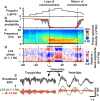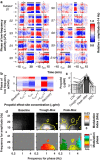A transition in brain state during propofol-induced unconsciousness
- PMID: 24431442
- PMCID: PMC3891963
- DOI: 10.1523/JNEUROSCI.5813-12.2014
A transition in brain state during propofol-induced unconsciousness
Erratum in
- J Neurosci. 2015 Jun 3;35(22):8684-5
Abstract
Rhythmic oscillations shape cortical dynamics during active behavior, sleep, and general anesthesia. Cross-frequency phase-amplitude coupling is a prominent feature of cortical oscillations, but its role in organizing conscious and unconscious brain states is poorly understood. Using high-density EEG and intracranial electrocorticography during gradual induction of propofol general anesthesia in humans, we discovered a rapid drug-induced transition between distinct states with opposite phase-amplitude coupling and different cortical source distributions. One state occurs during unconsciousness and may be similar to sleep slow oscillations. A second state occurs at the loss or recovery of consciousness and resembles an enhanced slow cortical potential. These results provide objective electrophysiological landmarks of distinct unconscious brain states, and could be used to help improve EEG-based monitoring for general anesthesia.
Keywords: Slow oscillation; anesthesia; cross-frequency coupling; propofol; unconsciousness; α rhythm.
Figures




References
-
- Avidan MS, Jacobsohn E, Glick D, Burnside BA, Zhang L, Villafranca A, Karl L, Kamal S, Torres B, O'Connor M, Evers AS, Gradwohl S, Lin N, Palanca BJ, Mashour GA. Prevention of intraoperative awareness in a high-risk surgical population. N Engl J Med. 2011;365:591–600. doi: 10.1056/NEJMoa1100403. - DOI - PubMed
-
- Benjamini Y, Yekutieli D. The control of the false discovery rate in multiple testing under dependency. Ann Stat. 2001;29:1165–1188. doi: 10.1214/aos/1013699998. - DOI
MeSH terms
Substances
Grants and funding
LinkOut - more resources
Full Text Sources
Other Literature Sources
Medical
